Homemade Tunisian Mlawi -recipe requires only a couple of ingredients. This is not the easiest recipe ever. But I am here to share with you all my tips and step-by-step tutorial that you will succeed without a doubt. Homemade Tunisian Mlawi is an essential part of Tunisian cuisine. And it happens to be super delicious! So go ahead, read on to discover my tricks and the recipe itself to make it perfect!
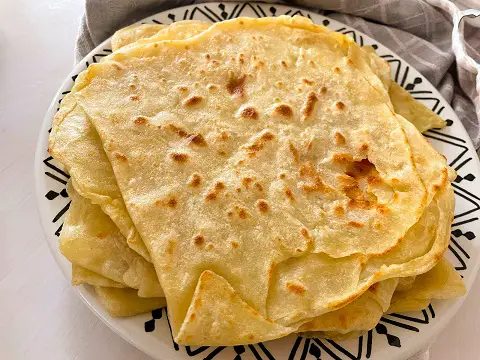
What is Tunisian mlawi?
The traditional Tunisian Mlawi is a thin flatbread made of very fine semolina, water, salt, and oil. Some like to add also dry yeast and flour. The dough is kneaded for a long time to create strong viscosity. The prepared dough is flattened with a generous amount of olive oil and finally folded into the desired shape. In the end, prepared Mlawis are cooked on the pan.
This tasty flatbread is very popular all over Tunisia. The most typical Tunisian way to eat this bread is a savory street food sandwich. From the small Mlawi shops you will get Mlawi sandwiches filled with savory fillings as harissa, slata mechouia, happy cow cheese, onion, tomato, hardboiled egg, tuna, donkey salami, etc. It’s very delicious, and if you feel hungry you can ask to have a double or triple Mlawis in your sandwich. And the best part is that it’s very cheap! Costs only a couple of dinars! Enjoy this treat with Tunisian soft drink Boga.
Mlawi can be eaten also on its own or as a sweet sandwich. Boost your Mlawi with ricotta, jam, chamia (sweet sesame paste), or butter. The very traditional way is to enjoy it with olive oil and honey.
Try these Tunisian recipes also!
Mosli- Tunisian chicken and vegetable stew
Kafteji- Tunisian fried vegetables
Traditional Tunisian chicken tajine
Tips you need to make the best Mlawi
During my Mlawi journey, I have made some mistakes. Here I am now, to tell you what not to do and what you should do. I hope these tips will help you! But let’s face it: homemade Tunisian Mlawi isn’t the easiest thing to prepare. If you fail on your first tries, it is completely normal. If you don’t fail, you are one kind of miracle
- Semolina needs to be very fine. If your semolina is too coarse it’s impossible to create viscosity into the dough. And do not try to grid coarse semolina to smaller, it won’t work either.
- If the dough seems too dry, it is most probably too dry. Don’t be afraid to add some lukewarm water little by little.
- Tunisian Mlawi dough requires a long time of kneading. The cooking stand mixer will be your best friend. I don’t own one so I use my hands. Kneading by hand works perfectly well but it takes more time. So, keep going around 15-20 minutes until the dough becomes white, smooth, and quite elastic. This is a very important part; you don’t want to leave kneading halfway.
- Prepared dough is divided into small balls. The balls will be flattened with a generous amount of olive oil/vegetable oil mixture. And I mean a GENEROUS amount, so don’t be shy!
- When folding the Mlawi, you can sprinkle semolina between the layers. Personally, I don’t do this.
- Heat the pan hot. Prepare one Mlawi at a time, fold it into desired shape and size. And immediately place it on the hot pan. When dark marks show on the bottom, it’s time to flip the mlawi. Once ready, remove and place it on the plate. Nb! Mlawi shouldn’t be hard and crispy. Aim to have softer, airy, and layered ones.
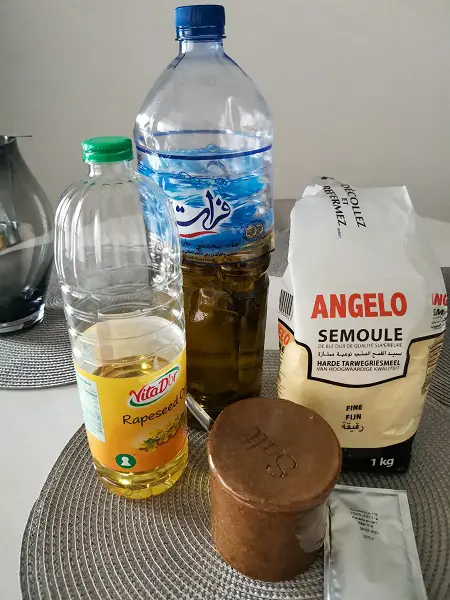
Ingredients to make a homemade Tunisian Mlawi bread
Semolina is made of durum wheat. To make Tunisian Mlawi choose semolina that is finely grounded. As I mentioned above, it’s impossible to create viscosity into the dough when the semolina is too coarse.
Flour is an optional ingredient. Some people like to replace about 1/3 of semolina with flour. This helps to create viscosity in the dough, and it also makes the dough a bit softer. Personally, I don’t use flour, and I haven’t heard that my relatives would use it either. But I have seen a lot of YouTubers using this trick. A fun fact is that semolina is also a better option for your health than flour.
Dried yeast is also an alternative ingredient. I use it to make mlawi. In my point of view, it makes the dough a bit airier. Definitely, you can skip this ingredient.
Salt for the taste!
Olive oil can be used in two phases: add a couple of spoons into the dough, and use it on the surface and when flattening and shaping the dough. I don’t put oil into the dough, and I use a mixture of ½ olive oil and ½ vegetable oil when flattening the dough. So, you can choose to use only olive oil or only neutral taste vegetable oil or make a mixture of two oils.
Homemade Tunisian Mlawi bread - recipe
Servings: 10 small or 6 big Mlawis
Total preparation time: 2 hours
Ingredients
500g very fine semolina
½ tsp salt
½ tsp dry yeast soaked in 1 dl of lukewarm water
2,5 dl lukewarm water
1 dl Olive oil /vegetable oil mixture (50-50)
How to make homemade Tunisian Mlawi bread: step-by-step.
Make the Mlawi dough
Step 1. Add ½ tsp of dry yeast into 1 dl of lukewarm water, stir until dissolved, and let it set for 10 minutes. The mixture should be bubbling a bit. (If not, your yeast is dead)
Step 2. Combine 500g of semolina and 1/2tsp salt. Stir gently. Add into the semolina mixture 2,5dl lukewarm water and the prepared yeast-water mixture. Mix everything together. If the mixture seems too dry, add some water little by little. We don’t want the mixture to be too dry.
Step 3. For kneading, you can use a stand mixer. Knead the dough at medium speed for about 10 minutes. If you are using your hands: Place the dough on the table and start kneading it by hand for about 15-20 minutes. The purpose of kneading any dough is to develop gluten. Stretch the dough and pull it back together, fold it, and push it. When the dough is ready, it will be whiter, firmer, tighter, and smoother.
Step 4. Place the dough into the bowl and give it a coating with 1/2dl of olive oil/vegetable oil mixture. Cover it and let it rest for 1 hour. The dough won’t rise too much.
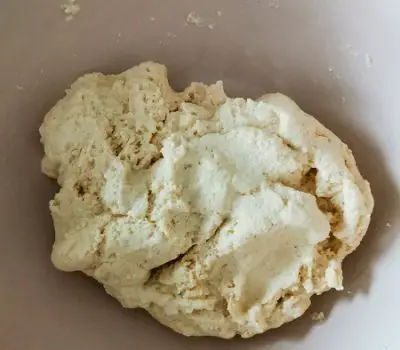
Dough before kneading
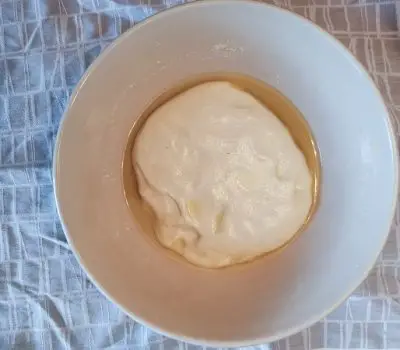
Dough after kneading and resting
Shaping and cooking the Mlawi
Step 5. Gently place the dough onto the clean work surface. Divide the dough into smaller balls, depending on what size you want your mlawis to be, and also how big is your frying pan. I made 10 small ones.
Step 6. Heat the pan. Take one mlawi ball, cover it well with olive oil and flatten it completely with your hands on your work surface. Add more olive oil mixture if needed. Some holes are alright as next, we are going to fold the dough into a square shape. Fold the sides and fold again to create a square. If the mlawi looks way too small, you can gently spread it out a little bit. Add more olive oil mixture if needed. Then immediately place the shaped mlawi on the hot pan.
Step 7. When brown spots appear on the bottom of the mlawi, it is time to flip the mlawi. And once again when the brown spots show on the bottom, transfer the mlawi on the plate and cover with a table cloth.
Step 8. Now it’s time to enjoy your homemade Tunisian Mlawi! Eat it on its own or make savory sandwiches and fold it like a burrito. Or serve with something sweet like honey, chamia, ricotta, or jam.
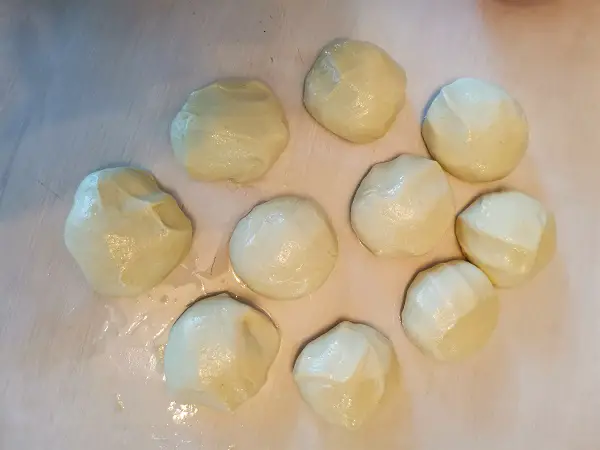
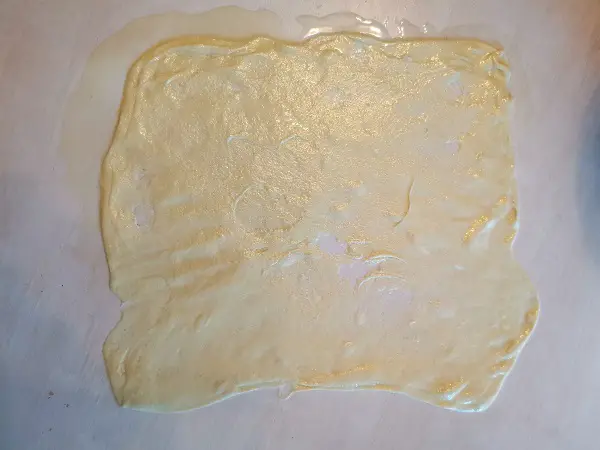
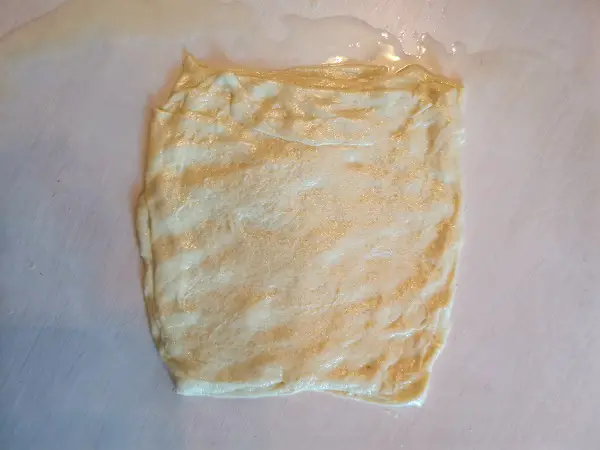
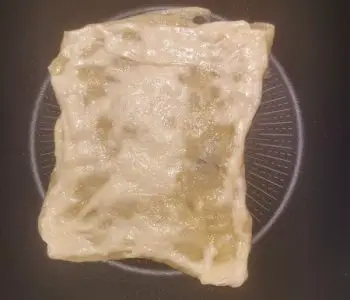
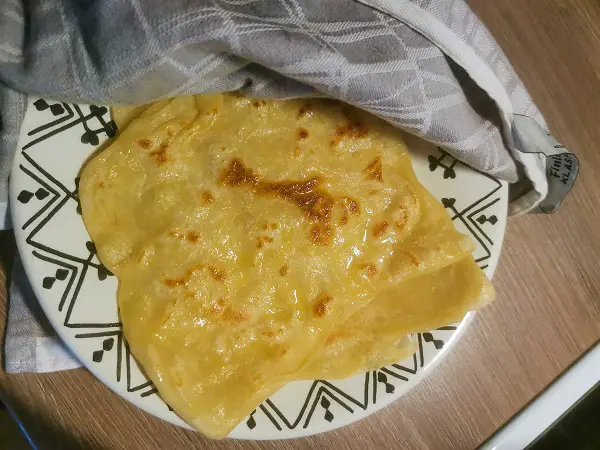
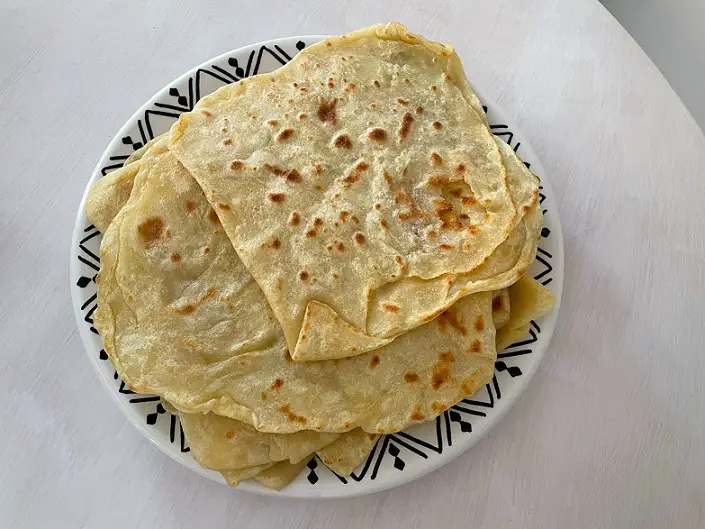
I hope you enjoyed this homemade Tunisian Mlawi – recipe. Let me know how is your Tunisian Mlawi journey going?

